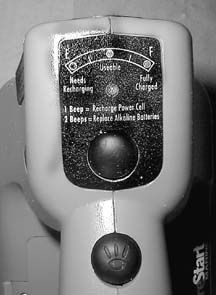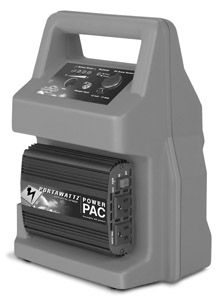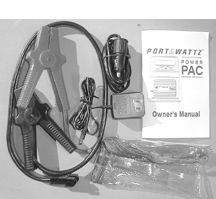In the October 15, 1999 issue we reported on four 17-pound, 17-amp-hour (Ah) battery power packs whose main purpose is to jump dead batteries, in this case the one that starts your boat’s engine. They are self-contained units with convenient carrying handles, short built-in jumper cables and a fused cigarette lighter jack for low-current uses.

Priced between $50 and about $150, we liked the Solar ES5000 above the Century 850, West Marine Roadmaster, and Superex 50-154U.
Three types of batteries are used in these portable units. The first is a sealed, lead-acid battery, which is in its chemistry basically like a typical car starting battery, only permanently sealed so electrolyte can’t be added or spilled. A step up is recombinant gel cell paste technology, which has all the features of the sealed lead-acid battery, plus the ability to hold a charge for more than three months and operate on its side. The battery can vent only if charged excessively or with too high a charge voltage.
The newest version of sealed technology is the absorbed glass mat (AGM) battery. It has extremely low internal resistance, allowing it to release all its charge very rapidly, without wasting any energy as internal heat. This type of battery also has great resistance to self-discharge, so it can last several months or more without needing to be recharged. It works just as well upside down as right side up—there’s virtually no liquid at all inside, only an electrolyte paste. It can, however, be damaged by excessive charging voltages. This is the only weakness of sealed battery technology—if you abuse the cell with an overcharge, you cannot fill it back up like an old fashioned cell with vent caps. Thus, permanent loss of capacity occurs.
Follow the recommendations in the manual and you will have no problems. Some portable generators put out dangerously high DC charging voltages and must be checked prior to use with any sealed battery.
AGM batteries are the mainstay of the better quality, 17 amp-hour portable power packs. They offer a lot of bang for the buck, and are capable of starting a large engine—we successfully started a 454 Chevy with one. They also can power many low-current DC appliances. Recharging times can be much faster than flooded cells. Unfortunately, the AC chargers supplied with most power packs are minimal, so any quick charging needs to be done with a DC adapter plug (sometimes included, sometimes optional) designed for a cigarette lighter socket.
Last year we had also wanted to test a similar unit from Bolder Technologies because of claims made about its new thin film design. Recently we were able to get our hands on a Bolder, as well as an interesting variant from Statpower. It is these two new units that are discussed in this report.
Bolder Technologies SecureStart 101
Bolder Technologies calls its new battery technology thin metal film (TMF). With this battery, virtually all internal resistance is gone, which means it is capable of discharging virtually every drop of power nearly instantly. The device tested comes in a 5-pound package, similar in appearance to a high-powered flashlight with a handle. In fact, it comes with a halogen flashlight built-in, powered by the TMF battery. There is also a set of nine AA alkaline batteries whose function we’ll explain in a moment.
To get an idea of the power available, think of a juice bottle with a tapered neck restricting the flow of liquid when it’s turned upside down. In spite of a large container, the liquid is constrained by the diameter of the opening. This loosely corresponds to a typical flooded battery. The internal make-up allows the discharge to progress only so fast. To achieve larger discharge current requires a larger container with a proportionally larger neck.
The TMF battery is like a slab of glass. Turn it upside down and all the contents (starting current) dump out immediately. Filling it back up is just as fast, depending on the volume of current available. Recharging times can be as fast as five minutes using the alternator on a vehicle’s engine.

This exceptional discharge capability allows a very small and light battery (six 1-Ah TMF cells) to start a 500-cubic-inch engine.
Is this voodoo or perhaps Star-Trek technology? While the energy discharge rate is phenomenal, the energy density is no greater than any other battery. Therefore, the SecureStart TMF still only has its stated 6 Ah capacity. This particular product is not for multipurpose use as a DC power source the way the other battery power packs previously tested were. They have 17 Ah to the Bolder’s 6 Ah. But for the specific purpose of emergency vehicle starting it does the job in a very lightweight package.
The Math
While starting an engine takes hundreds of amps of current, the time is normally so short that in a typical starting battery not much net capacity is tapped. Let’s look at an example. A small four-cylinder gas engine may take 400 amps to turn over. If you crank for 15 seconds that only takes 1.66 Ah out of the battery—400/(60×4).
Other real world tests on current draw were performed on a 2.2 liter Toyota at 425 amps and on a 350 Chevy V-8 at 857 amps. The Bolder SecureStart can easily handle these engines, but with proportionally shorter crank times that will be measured in 10-15 second spurts—not in minutes as a full-sized battery can provide. As long as the engine is in good shape, seconds are all you need to start it. According to the Bolder web site FAQs, this unit will not start an automotive diesel engine. However, if you have a very small diesel that can be quickly started by a typical single group 24 battery, it probably will work.
Consider also that in most instances the ship’s battery is only partially discharged and the jump starting battery actually is piggybacking on the partially discharged starting battery, getting the voltage threshold high enough to sufficiently sustain the pair to engage the solenoid and spin the starter.
Testing Details
Starting engines is too imprecise to get an accurate handle on how long the Bolder battery will crank any given engine, so we used a standard, high-current battery tester that places a 100-amp pure resistive load on the test battery (approximately .116 of 1 ohm at 12 volts). The test wire is similar to an electric hot plate, and glows just as bright.
We used a new group 34 Optima starting battery to establish some baselines of what a full-sized battery can do. The Bolder gave about 15 seconds versus five minutes for the full-sized battery, but 15 seconds is more than enough to start a healthy engine.
As stated, you’ll get more cranking time if the built-in battery is not completely flat. If you need to try again after running the Bolder battery out of juice, and have an outside AC source, the small AC charger that comes with the Bolder battery will recharge it in about two hours. Using another vehicle’s alternator, the recharge time can be cut to as little as five minutes, depending on the output of the alternator (or generator).
The TMF battery only lasted about 25 minutes with a 5-amp, resistive load, about half of what was expected. That’s why this device is strictly rated as a starting unit, and not to power small DC loads.
Device Details
The unit is claimed to be capable of 1000 peak amps and is rated for 500 charge/discharge cycles. Bolder predicts a four- to five-year life for the TMF battery. When it fails you can ship it back to the factory for replacement. The battery can be recycled. Currently, the device is registered with UL but not currently approved by them.
The design uses nine alkaline AA cells (in addition to the TMF cells) for several functions. The manual is confusing as to just what the AA alkalines are for and whether they are the rechargeable type (they’re not). They provide a trickle charge for the TMF battery while it’s in storage and power the monitoring electronics consisting of a beeper and three color LEDs to give visual charge status. The TMF batteries power the built-in flashlight, so using that light simultaneously diminishes the starting capability. The light only works when the button is held down.
The manual states the unit can withstand being submerged in water without damage. The manual also states that special materials and coatings are used to reduce the harmful effects of the marine environment.
The unit is designed to remain ready to work for as long as a year between charges. In warmer temperatures and to extend the life of the alkaline batteries, recharging every three months for 24 hours is recommended. It should not be left permanently on charge. There are two versions, a marine unit and an automotive unit. They have the same capabilities, but the marine unit is supposed to be more corrosion-resistant.
The SecureStart model 101 comes with an AC wall charger and a nylon carry bag. An optional, 12-volt DC accessory charger plug is available for $30, plus shipping (expensive). The unit comes with a limited two-year warranty. The price is around $120.
Conclusion
Would we buy one? Only if space and weight are truly at a premium, or if 5 pounds is all that you want to handle. The unit does what it claims in that it will start an engine, albeit with a short but effective crank time. It’s not recommended for diesels. For the same money you can get a 17-Ah AGM battery that has three times the duration for low current needs as well as longer starting current capability, or one with a built-in 300-watt inverter for not much more money (see the Statpower next).
The Bolder unit is a one-trick pony, but it’s indeed quite a trick. It’s likely you’ll be seeing more variations on the thin film technology, including greater amp-hour capacities. (Bolder Technologies, 4403 Table Mountain Dr., Golden, CO 80403; 877/215-7278, www.boldertmf.com.)
Statpower Portawattz Power Pac
This unit has a built-in Statpower Portawattz 300-watt continuous and 500-watt surge, high-frequency, modified sine wave inverter for AC power needs. The inverter is molded into the side of the battery pack case. The DC battery is an 18-Ah sealed AGM battery that needs no water and is spillproof. The battery has enough oomph to start a car or power a small TV or laptop computer for hours.

The power packs tested last year were priced as low as $50 in a discount store for a no-name Chinese battery, to $150 for a Canadian-made unit with a brand name AGM battery. This Statpower unit with an AGM battery and built-in AC inverter (its removable) sells for about the same price of $150.
With this unit you can eliminate lugging around a separate inverter to run, say, a laptop computer, because not everyone has a special DC cable to run his or her laptop on DC juice— for some people the inverter is necessary.
Unique to the Statpower unit are detachable jumper cables via a high-current connector. Suddenly, the rather ugly, purpose-built look of the other battery packs becomes a stylish AC/DC blue power container.
In testing, the inverter was quite resistant to putting out RFI—much more so than any other previously tested power pack. We cannot guarantee it will not cause problems with your equipment, so test for it right away. Some AC-only TVs will work fine; others will have electrical noise. Better quality units generally do okay. Tests showed the battery will last about 7 hours at a 1.8-amp draw and 2 hours at 6 amps. The manual is very good.
Two chargers are included, an AC wall charger and DC charger that plugs into a cigarette lighter plug. The AC charger, unlike the primitive chargers from other brands, is a two-stage unit. This allows the unit to be left plugged in at all times without battery harm, so it’s always ready for full power use. Charging takes 18 hours (similar to other brands), but if you leave the other brands plugged in via the AC charger the battery will be eventually be harmed by excess voltage. A DC charging plug also comes with the unit for use with a cigarette lighter plug. This process is much faster—in the order of three to four hours, depending on receptacle output.

The rubber-covered DC-out plug on the Statpower has a current limit of 12 amps. If you exceed that an internal circuit breaker will pop and, after a rest, reset. Many others brands use a fuse that requires toting a replacement. There is also a status panel giving the state of charge. There is an auto shutoff on the inverter at the 10-volt point to prevent over-draining the battery (an alarm sounds at 10.7 volts). The inverter also has a surge capacity of 500 watts, meaning AC devices that cause a power surge when started will work. (An example would be a TV.)
The warranty is for one year and the battery is replaceable. Weight is about 17 pounds, and dimensions are 6″ x 9″ x 12″. Included is an AC adapter, DC charger/power cord, detachable jumper cables and plastic pouch to hold accessories.
The Statpower Power Pac can be found and purchased on the web (www.store4power.com) for about $150. Full retail is $199. (Statpower Technologies, 7725 Lougheed Hwy., Burnaby, BC V5A 4V8, Canada; 604/420-1585, www.statpower.com.)





































i have an ss101 and it needs a new rechargeable main cell (battery) the article said i can send it in if so where do i send it or can i buy the part and do it myself. 2nd ques how much is the battery and is it worth it to even d0 it thanks jeff az